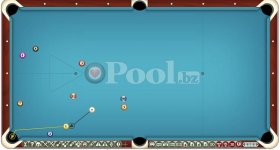For anybody who cares to comment, let's say you have this situation. The table is open and the 11 is my break ball. The 1 ball only passes the 2 ball if I hit the facing of the pocket. If I hit at all into the pocket and not squarely on the facing then I will touch the 2 and miss. You have a bit of an angle with the cue ball so it isn't like you can line up the cue ball/1 ball straight in and really sight to the pocket facing. There is very little room for error.
So the question really isn't about your other options on this layout. It is about whether you believe this shot should be a "no brainer," and if it isn't then you better improve your pocketing skills. Obviously, for me, I believe it is a little "iffy." After all, the name of the game is to keep the shots simple. Is this a case of maneuvering around to eventually get on the 2, or just knock the 1 in because you are supposed to be able to make this shot?
I'm interested in your thoughts. Oh, obviously I missed the shot.
So the question really isn't about your other options on this layout. It is about whether you believe this shot should be a "no brainer," and if it isn't then you better improve your pocketing skills. Obviously, for me, I believe it is a little "iffy." After all, the name of the game is to keep the shots simple. Is this a case of maneuvering around to eventually get on the 2, or just knock the 1 in because you are supposed to be able to make this shot?
I'm interested in your thoughts. Oh, obviously I missed the shot.
